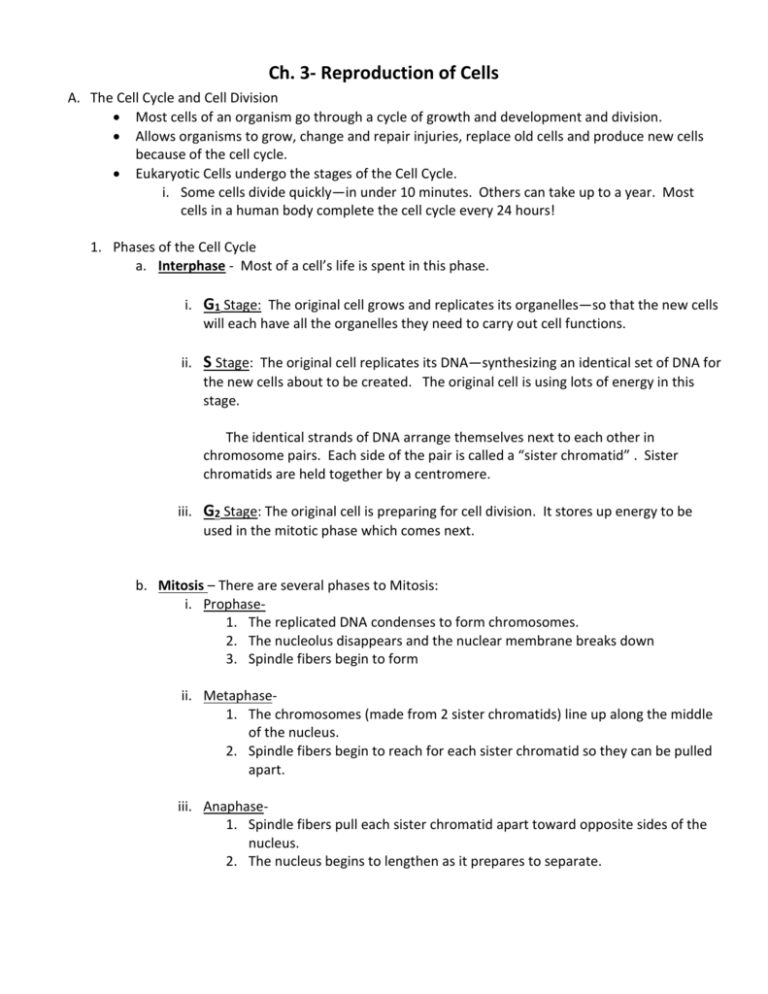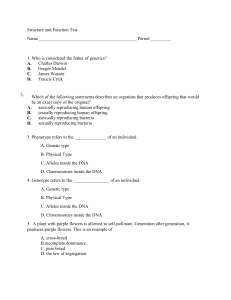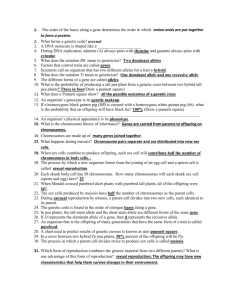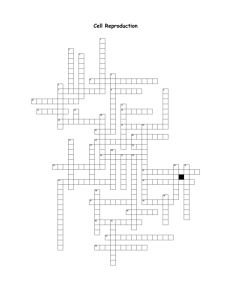Ch. 3-4 Mitosis, Meiosis and Asexual Reproduction Outline
advertisement

Ch. 3- Reproduction of Cells A. The Cell Cycle and Cell Division Most cells of an organism go through a cycle of growth and development and division. Allows organisms to grow, change and repair injuries, replace old cells and produce new cells because of the cell cycle. Eukaryotic Cells undergo the stages of the Cell Cycle. i. Some cells divide quickly—in under 10 minutes. Others can take up to a year. Most cells in a human body complete the cell cycle every 24 hours! 1. Phases of the Cell Cycle a. Interphase - Most of a cell’s life is spent in this phase. i. G1 Stage: The original cell grows and replicates its organelles—so that the new cells will each have all the organelles they need to carry out cell functions. ii. S Stage: The original cell replicates its DNA—synthesizing an identical set of DNA for the new cells about to be created. The original cell is using lots of energy in this stage. The identical strands of DNA arrange themselves next to each other in chromosome pairs. Each side of the pair is called a “sister chromatid” . Sister chromatids are held together by a centromere. iii. G2 Stage: The original cell is preparing for cell division. It stores up energy to be used in the mitotic phase which comes next. b. Mitosis – There are several phases to Mitosis: i. Prophase1. The replicated DNA condenses to form chromosomes. 2. The nucleolus disappears and the nuclear membrane breaks down 3. Spindle fibers begin to form ii. Metaphase1. The chromosomes (made from 2 sister chromatids) line up along the middle of the nucleus. 2. Spindle fibers begin to reach for each sister chromatid so they can be pulled apart. iii. Anaphase1. Spindle fibers pull each sister chromatid apart toward opposite sides of the nucleus. 2. The nucleus begins to lengthen as it prepares to separate. iv. Telophase1. Nuclear membrane begins to form around the chromosomes as they begin to unwind. 2. Spindle fibers break down 3. Two new nuclei form c. Cytokinesis i. The original cell’s cytoplasm divides during this stage, creating two identical “daughter cells” 1. Daughter cells are genetically identical. The original cell no longer exists. Ch. 4 The Reproduction of Organisms A. Sexual Reproduction a. Advantages-Because DNA is exchanged, there is variation among individuals of a species which makes species strong b. Disadvantages-Offspring often take time to form and develop. Not as rapid as asexual reproduction. c. A type of reproduction in which the genetic material from two different cells combine to produce an offspring. i. Sex cells combine in a process called fertilization 1. Egg-female sex cell 2. Sperm-male sex cell ii. Fertilization results in a new cell called a zygote. 1. The zygote develops into a new organism a. The new organism will form 2 types of cells as it grows and develops i. Body cells—formed by mitosis and the cell cycle 1. Body cells are diploid cells. This means that chromosomes occur in pairs within these cells. a. Pairs of chromosomes that have genes for the same traits in the same locations are called homologous chromosomes. ii. Sex cells—formed by meiosis 1. Egg and Sperm cells are haploid cells. They only have half of the chromosomes of body cells. B. Meiosis—The process of a diploid body cell dividing and dividing again resulting in a haploid cell—a cell with only half of the DNA it’s supposed to have. When sex cells join, each contributes half of the DNA that the zygote will need. a. Meiosis I: A reproductive cell undergoes interphase where it grows and develops, and duplicates its DNA into chromosome pairs. Each side of a chromosome is a sister chromatid joined by a centromere. i. Prophase I1. Nuclear membrane breaks apart 2. Chromosomes condense and form homologous pairs joined by centromere ii. Metaphase I1. Homologous chromosomes line up across the center of the nucleus 2. Spindle fibers attach to the centromeres iii. Anaphase I1. Homologous chromosomes pull apart and are drawn to different sides of the nucleus. iv. Telophase I1. Nuclear membrane forms around each set of chromosomes 2. The cytoplasm divides forming 2 daughter cells b. Meiosis II- The two cells formed in Meiosis I go through a second division of the nucleus and the cytoplasm so that the resulting cells are haploid—having half of the DNA of a diploid cell. i. Prophase II—Nuclear membrane breaks down ii. Metaphase II—Sister chromatids line up along the center of the nucleus iii. Anaphase II—Sister chromatids of each chromosome begin to separate and are pulled to opposite ends of the cells. iv. Telophase II—A nuclear envelope forms around the each set of chromatids and the cytoplasm divides resulting in 4 haploid sex cells. C. Asexual Reproduction a. A single parent organism produces offspring without meiosis and fertilization. i. Advantages—organisms can multiply very quickly this way because there is no competition to find a mate ii. Disadvantages—Little variation among species (And variation we will learn makes a species very very strong.) and mutations, if harmful will be repeated rapidly, harming the species. iii. All offspring are genetically identical with the parent organism because no DNA is shared. There are many types of asexual reproduction: 1. Fission-Cell division in prokaryotes that results in genetically identical offspring a. Plasmid/genetic material is copied b. Prokaryote elongates and then splits into two i. Example—Bacteria reproduce with fission 2. Mitotic Cell Division—Unicellular eukaryotes such as amoebas undergo the stages of mitosis and produce two genetically identical daughter cells. 3. Budding—Multicellular organism that reproduces asexually when a new organism buds on the side of a parent organism and grows through the process of mitosis and cell division. a. Sometimes offspring stay attached to the parent, other times they separate. b. Example: Hydra reproduce by budding 4. Animal regeneration—Occurs when an offspring grows from a piece of a parent a. Example: Planaria, sea cucumbers, sea urchins, sponges regenerate to produce genetically identical offspring. 5. Vegetative Reproduction—a form of asexual reproduction in which offspring grow from a part of a parent plant. Offspring are genetically identical to parent. 6. Cloning—A type of asexual reproduction that takes place in a lab that produces individuals from a cell or from a cluster of cells taken from a multicellular organism. a. Cloning is used to produce offspring with favorable traits such as resistance to disease or size, or quickness of growth. i. Plants used for food ii. Endangered animals may soon be cloned to increase their numbers.







